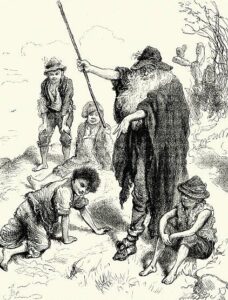Immortals and Itinerants July 1, 2023
Author: Beach Combing | in : Modern , trackbackThis month’s Boggart and Banshee Podcast concerns the immortals in our midst: the men and (in some rare cases) the women who are supposed to live for ever. I’ve long been interested in the most famous of these, the Wandering Jew: the individual cursed by Christ who traipsed from place-to-place imparting wisdom or (in some parts of Europe) cholera. In fact, I’ve just brought out, with Pwca, a source book of all the encounters with the Wandering Jew that I have been able to find for Britain (UK) (US). They range from the pedestrian (shadows glimpsed in London streets) to the absolutely bizarre (a Scottish Wandering Jew who flabbergasts a botanist by jumping off a cliff).
In doing the project I’ve been struck by two things. First, the way in which the canon of immortals ‘in our midst’ go far beyond the Wandering Jew to include others: from the Count of St Germain to the Lonely Saint, from Rip Van Winkle to Tiresias. There is a book waiting to be written on this subject. Perhaps this recent offering from the Anomalist is what we need. I haven’t yet had a chance to read it. Then, second, I have found it remarkable how many of these immortals are associated with an itinerant tradition. They move from place to place and are often mendicants. There are a number of modern encounters with tramps who are supposed to have hardly changed at all over decades. If anyone has any references to these please, btw, send them in: drbeachcombing AT gmail DOT com.
Why is there this connection with itinerancy? The most obvious explanation is that the Wandering Jew tradition has contaminated other immortal traditions. But perhaps there is something else. The itinerant – be it the gypsy on the edge of town or the foreign pedlar moving from settlement to settlement – is a mystery. We know little about these tramping folk and it is easy to project tales onto their fleeting personas. He or she awakens, as they shuffle through our streets, pity, curiosity and hostility and often a strange mix of these three. The fact that itinerants are more likely to suffer from mental illness creates larger than life figures in local folklore. The fact that the itinerants often return gives, meanwhile, a seasonal quality to their visits: they seem part of the natural not the human order. Then, of course, the fact that we barely know them, means that when thirty years have passed and someone who looks like them reappears to beg or sell we can confuse the new face with early editions.



